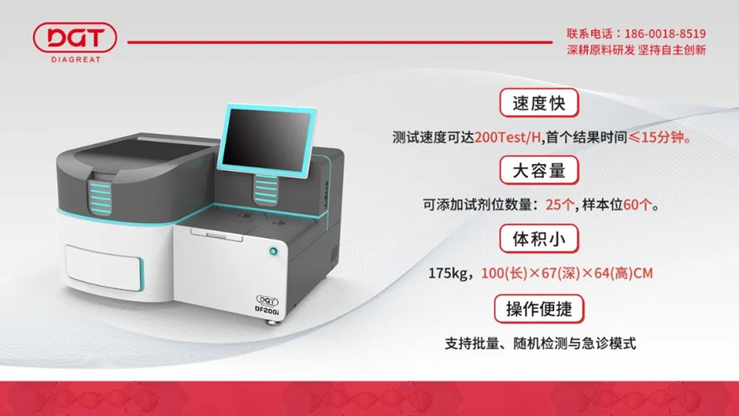At present, tumors, especially malignant tumors, have become one of the most serious diseases that threaten human health. Chemotherapy, radiotherapy, surgery, biological therapy, and integration of traditional Chinese and Western medicine are the most effective means to treat tumors. Among them, the application of new anti-tumor drugs has played a huge role in improving the quality of life of cancer patients, prolonging the survival time, and delaying the disease progression.
Different patients have different dosage needs. If using average dose according to the traditional method, due to some individual differences and other factors, some patients will not be well treated, some will not achieve the expected curative effect, and even occur toxic and side effects. This requires us to monitor the drug concentration to determine a relatively safe and effective blood concentration range. Therapeutic drug monitoring (TDM) can guide patients' individualized and precision medication.
Clinical Application of Antineoplastic Drugs
Cytotoxic antineoplastic drugs, methotrexate, 5-fluorouracil and paclitaxel are mainly used in the clinical treatment of various malignant - tumors. Methotrexate can also be used to treat rheumatoid arthritis, but it needs to pay attention to its anti-rheumatic and anti-tumor treatment, as the medication is not the same level at all!
Methotrexate
- Large dose (>500 mg/m2) Methotrexate has a significant effect on a variety of malignant tumors, such as Non-Hodgkin's Lymphoma (NHL), Acute Lymphoblastic Leukemia (ALL), osteosarcoma, malignant tumors of the head and neck, and bronchial lung cancer.
- Small dose (≤50 mg/m2) Methotrexate can be used to treat rheumatoid arthritis (RA), psoriasis, etc.
5-fluorouracil
- Adjuvant chemotherapy and palliative treatment of breast cancer, gastrointestinal cancer tumors (primary and metastatic liver cancer, biliary system cancer tumors and pancreatic cancer), ovarian cancer and primary bronchopulmonary adenocarcinoma.
- Intra-arterial chemotherapy for head and neck malignancies and liver cancer.
- Treatment of malignant mole and choriocarcinoma, cancerous effusions in serous cavities, and endoluminal therapy for bladder cancer.
Paclitaxel
- It is mainly effective in the treatment of ovarian cancer.
- It also has a certain effect on non-small cell lung cancer, breast cancer, gastric cancer, esophageal cancer, head and neck tumors, and is also used in the treatment of Kaposi's sarcoma.
Why do we need to monitor the drug concentration of antineoplastic drugs?
Most antineoplastic drugs have the characteristics of low therapeutic index and high toxicity. There are wide differences in the process of absorption, distribution, metabolism and excretion in the body. Liver and kidney damage are also common in cancer patients. Even if the same dose of antineoplastic drugs is given, the drug blood concentration can vary by 3 to 10 times. There are often problems in treatment that insufficient dosage leads to poor curative effect or overdose leads to serious side effects. TDM can effectively reduce the incidence of toxic and side effects, improve the efficiency of treatment, and realize individualized and precision medication.
Methotrexate (MTX): Many drug interactions.
Compete for plasma protein binding sites, reducing the binding rate of MTX protein. Affects transporters, interferes with renal tubular secretion, and inhibits renal excretion of MTX. Affects renal clearance. Changes in urine pH, affect the solubility of MTX.
5-fluorouracil (5-FU): The therapeutic dose is close to the toxic dose.
Given the same dose of 5-FU, the blood concentration can vary by 3-10 times, or even more.
Most patients do not reach the optimal drug exposure, and only 20%-30% of patients have therapeutic concentrations within the effective range.
Paclitaxel (PTX): Nonlinear Pharmacokinetic Characteristics.
Efficacy and adverse reactions are closely related to blood concentration and drug exposure time.
Diagreat antineoplastic drugs TDM solution
In order to meet the clinical needs of tertiary hospitals and primary medical institutions, Diagreat has launched antineoplastic drugs TDM solution based on chemiluminescence immunoassay and fluorescence immunoassay: central laboratory chemiluminescence solution (methotrexate) and point-of-care POCT solutions (methotrexate, 5-fluorouracil and paclitaxel).

Contact: 186-0018-8519
Working hard in conquering raw material research & development, keeping on independent innovation.
Fast
Testing speed up to 200 test/hour, the first result time ≤ 15 min
High capacity
25 reagent locations, 60 samples locations.
Small size
175kg, 100(length)*67(depth)*64(height)cm
Easy operation
batch testing mode, random testing mode, emergency mode
Therapeutic drug monitoring (TDM) Programs
Classification | Reagent name | Abbr. | Testing range | Sample type |
Antineoplastic Drugs | Methotrexate determination kit | MTX |
| Serum, plasma |
Paclitaxel determination kit | PTX |
| Serum, plasma |
5-fluorouracil determination kit | 5-FU |
| Serum, plasma |
Routine inspection programs
Classification | Reagent name | Abbr. | Clinical significance | Sample type |
Tumor markers | PG-I determination kit | PG-I | Early screening of gastric cancer, auxiliary diagnosis of chronic atrophic gastritis | Serum, plasma |
References
1. Zhang Haiyan et al. Therapeutic drug monitoring of anticancer drugs: research advances. Journal of International Pharmaceutical Research, Volume 45, No. 5, May 2018
2. Liu Shuang et al. Effects of combined medication on the safety of high-dose methotrexate:A systematic review. The Chinese Journal of Clinical Pharmacology, Volume 35, No. 14, July 2019
3. Shi Jing et al. Research status of therapeutic drug monitoring of 5-fluorouracil. The Chinese Journal of Clinical Pharmacology, Volume 32, No. 11, June 2016